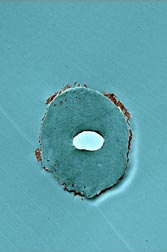This is a story about nutraceuticals or, more specifically, about nanotechnology and food according to a Jan. 20, 2014 news item on Azonano,
Food scientist Hang Xiao of the University of Massachusetts Amherst recently received a four-year, $491,220 grant to study the biochemical fate of nanoemulsion-based food delivery systems in the gastrointestinal (GI) tract, hoping to re-shape them and enhance the absorption of beneficial food components encapsulated in delivery systems.
Food biochemists like Xiao believe that if taken up in appropriate amounts and forms, certain food components known as nutraceuticals might benefit human health by providing anti-inflammatory or anti-cancer effects. Nutraceuticals include flavonoids and carotenoids in fruits and vegetables, for example.
This project, supported by the U.S. Department of Agriculture’s National Institute of Food and Agriculture, will focus on manipulating the structure and composition of nano-emulsion delivery systems to modify the fate of encapsulated nutraceuticals in the GI tract to enhance their bioavailability.
A Jan. 17, 2014 news release on EurekAlert, which originated the news item, explains further,
“In the last decade, knowledge has been advancing about how to effectively deliver beneficial components in food. This research will allow us to direct the assembly of nano-emulsion droplets to create characteristics that will dictate how they are digested and absorbed,” Xiao explains. “This would be a model for nutraceutical delivery in a wide range of food products. Someday prepared foods may help lower our risk of cancer, for example.”
Specifically, using both cell culture and animal models, Xiao and colleagues will design lipid nanoparticles at three stages: From nano-emulsion droplets containing nutraceuticals, to mixed micelles and finally to chylomicrons. To start this process, digestion physiochemically disassembles nano-emulsion droplets. The resulting chemical components are then assembled into mixed micelles in the small intestine, where epithelial cells called enterocytes take them up. There they are reassembled into chylomicrons and absorbed into blood circulation through the lymph system.
The scientists want to influence the size and composition of chylomicrons, because these characteristics dictate the fate of nutraceuticals encapsulated in the chylomicrons. Certain sizes and compositions are better able to deliver nutraceuticals to the lymph system, which protects nutraceuticals from being cleared by the liver. This will enhance bioavailability of flavonoids and other beneficial compounds to the body, potentially offering health benefits.
“We’re basically utilizing what already happens in our bodies all the time, but introducing food-grade nano-emulsion systems that can influence the nature of mixed micelles as well as chylomicrons,” says Xiao. “It’s safe, it’s all digested and simply delivers beneficial food components to a greater extent than if the system was left alone.”
Given that this falls under my nanotechnology and food classification, I was reminded of a recent panel discussion on the topic held by the UK’s Guardian newspaper, from my Oct. 29, 2013 posting,
There’s no indication as to what the 25 audience members thought about the session although Hilary Sutcliffe of Matter was quoted,
Audience member Hilary Sutcliffe, director of the Matter think tank on responsible innovation, was keen to emphasise the limits of nanotechnology in food. “If we’re really lucky, we might get nanosalt and a couple of nano-encapsulated vitamins that go in products,” she told the panel, describing her disappointment in the progress of nanotechnology in food to date.
Sutcliffe explained that these limited applications are expensive and not that useful: manufacturers would rather just reduce salt content than pay for nanosalt, and vitamins and flavourings do not need to be nano-encapsulated because they can be added to foods at the microscale, rather than at the nano-level, which is one thousand times smaller.
She also suggested that, so far, the possible uses of nanotechnology have only been in Western diets and that people should be realistic about its use for tackling the impending global food crisis. “Nothing about nanotechnology is in relation to anything except Western, expensive foods that are slightly gratuitous and not particularly necessary,” she said, before adding that it is not currently helping to feed the world. “If you are going to talk about feeding the world, be brave, take on GM, let’s have that discussion.”
I was not able to find notice of any US public engagement sessions on the topic of ‘nano and food’. If you know of any such sessions, please do share in the comments section.
